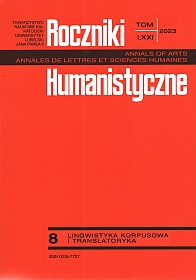« Pain azyme » – c’est-a-dire ? Comment comprendre la caracteristique essentielle du pain eucharistique
Unleavened Bread, but What Kind? On Understanding the Essential Characteristic of the Eucharistic Bread
Author(s): Anna Słowikowska, Grzegorz WojciechowskiSubject(s): Language and Literature Studies, Translation Studies
Published by: Towarzystwo Naukowe KUL & Katolicki Uniwersytet Lubelski Jana Pawła II
Keywords: Eucharistic bread; the Most Holy Eucharist; Divine Liturgy; unleavened bread; ancient Christian tradition
Summary/Abstract: The legislator of the 1983 Code of Canon Law sets forth the legal requirements for the validity of the substance of the Eucharist. In Can. 925 § 2, he included the disposition that the bread should be of wheat alone and recently made. In the General Instruction to the Roman Missal, however, these requirements are supplemented by an indication that the Eucharistic bread should also be unleavened (no. 320).The purpose of this paper is to show the latter feature as essential and symbolic, but not absolutely necessary in the context of the validity of the Eucharistic substance in the Catholic Church, because in the Latin liturgy the Eucharist is celebrated with unleavened bread, while in some Eastern Catholic Churches the Divine Liturgy is celebrated with leavened bread.The answer to the research problem posed in this way will be preceded by a linguistic analysis, in which the origin of the Polish adjective przaśny (‘unleavened’) will be explained, with references to the source Greek ἄζυμος, its derivative Latin azymus, and its French borrowing in the form of azyme (sans levain).
Journal: Roczniki Humanistyczne
- Issue Year: 71/2023
- Issue No: 8
- Page Range: 143-155
- Page Count: 13
- Language: French

